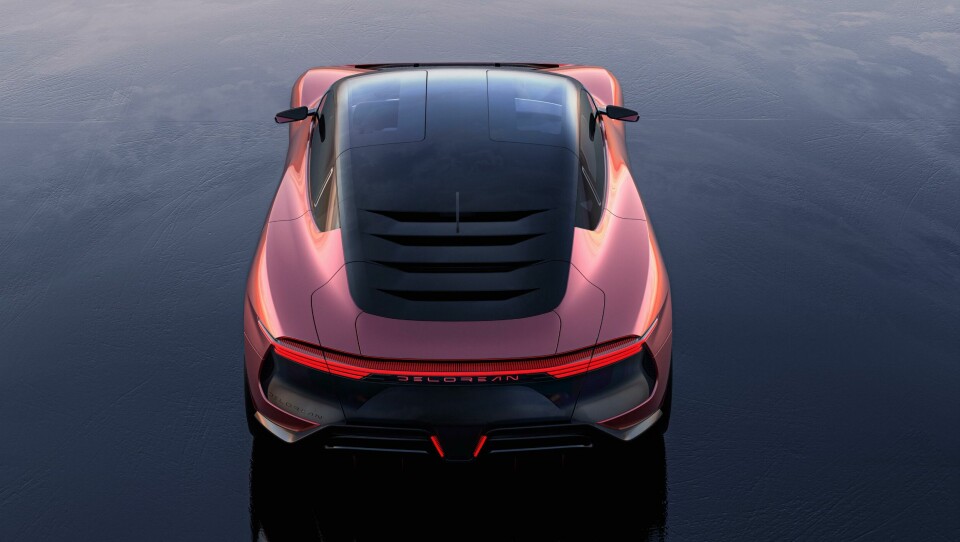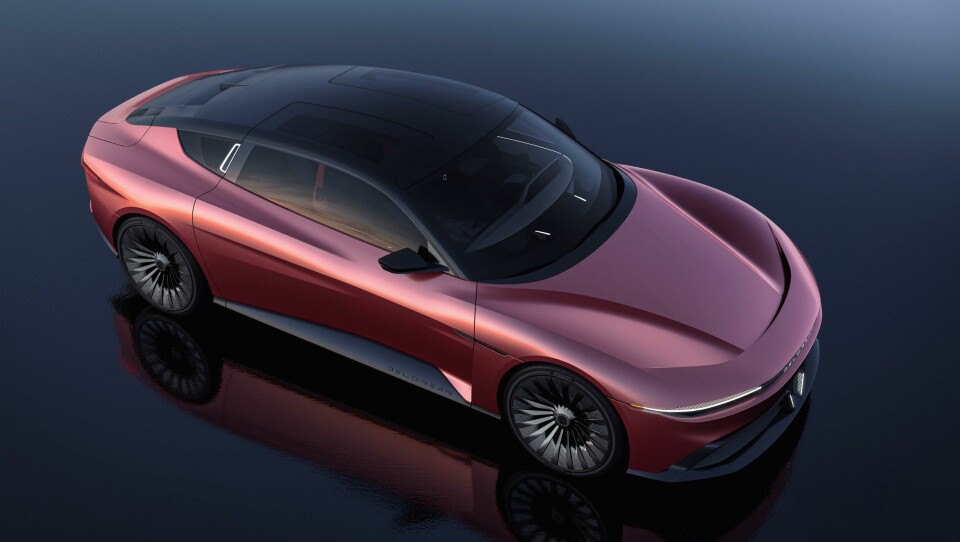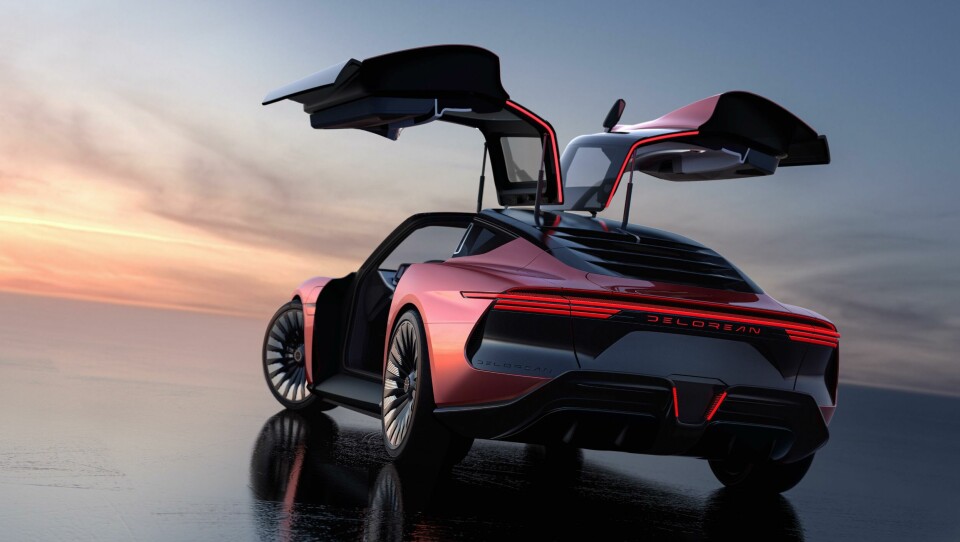
“Art over aero” – DeLorean dissects 2022 EV concept
The team behind the new-look DeLorean spoke with Car Design News about the upcoming electric vehicle concept, sharing exclusive artwork and an idea of where the brand is headed in future
With a hotly anticipated concept due to grace the shores of Pebble Beach in August, DeLorean is back with a bang. But it is more than just a brand renaissance: under new management, the company aims to rejuvenate classic ideals around car design, openly stating that electric driving range will be sacrificed in favour of design beauty.
The DeLorean name is synonymous with the DMC-12 from the 1985 film Back to the Future. Few brands are tied so closely to just one particular car – or film. Fittingly, the company plans to bring back style cues from the past and rejuvenate what it sees as a dying breed: a performance coupe with aesthetics put first. Weeks ahead of the official launch, Car Design News sat down with the team behind the Alpha5 concept to find out more.

The challenge is that electric vehicles (EVs) remain a tough sell for many drivers, and the industry has moved past the point of early adoption. Once a chance to stand out from the crowd, EVs have since become ubiquitous. To attract buyers, the focus has turned to boosting driving range and cutting charging times. That puts engineering ahead of aesthetics, and in practical terms, means new EVs are built with aerodynamics at the helm.
This is true for models across all segments – the Lotus Eletre SUV was recently revealed under the banner of being ‘carved by air’ – and has meant that many models rolling off the production line are exceptionally sleek, almost bullet shaped. While pushing the usefulness of EVs forward, the approach may not always lend itself to a bedazzling exterior. This is a generalisation of course, but the trend is undeniable.
The new team at DeLorean – and its outsourced design house, Italdesign – are having none of it. Troy Beetz, Chief Marketing Officer at DeLorean, goes as far to say that the focus on design is even influencing the automaker’s hiring process. Engineers are told in no uncertain terms they must accept that aesthetics comes first. For them, part of the challenge will be to find solutions that ensure drivability requirements do not impact how the vehicle looks and feels.
“We are reinventing the company in an era where design is all about automation and electric driving range. But when you declare something like that, you are immediately impacting design and sacrificing it for more miles,” says Beetz. “We wanted a brand that focussed purely on design and functionality – the driving aspect of a vehicle. We want to take the kind of visceral sensation you get from a Porsche 911 and bring that into an EV, even if it means compromising on range. We’re not going to concede to the demands of engineering teams and aerodynamics.”

The Italdesign team behind the DeLorean project was sizeable, with different exterior, interior, HMI, colour and materials experts on hand, not to mention different virtual and physical modellers. As for why Italdesign got the gig over other design houses, Beetz explains that “it was the only one up to the challenge.”
The Turin-headquartered company also has a legacy with DeLorean, having been involved in the original DMC-12. Dario Lauriola, a senior automotive designer at Italdesign who led the project, says it is not only the rebirth of a car but of the relationship between the two firms. “It was interesting from the point of view that we had people in the company who worked on the old car,” he told Car Design News. “It gave a huge meaning to the final product.”
By figuring out the DeLorean DNA, we could imagine which features might extend from the original car to the modern day
For Lauriola, working with DeLorean posed an interesting challenge. For veterans in automotive design, the DMC-12 would likely have been an icon as they carved out their careers in the industry. But at 29 years old, Lauriola was not even alive when the DMC-12 was first revealed or when Back to the Future first aired. Although an experienced designer in his own right, he recognises that he might have taken a different approach to DeLorean’s incarnation compared to others.
“On one hand, you could say I am quite young but I do have quite a bit of experience. I’ve been with Italdesign for seven years, and before that with other car makers,” he says. “I remember watching the film with my father when I was young, so I do feel a kind of connection with DeLorean. The DMC-12 is definitely a special car.”

With any relaunch of this nature, there are two potential avenues: replicate the original or start afresh. “The brief was about trying to understand the DNA of the car, not to do a revival,” explains Lauriola. “By figuring out the DNA, we could imagine which features might extend from the original car to the modern day.”
Car Design News recently gained a behind-the-scenes look at the upcoming concept. Several design elements do carry over from the DMC-12, but it is a world away from the boxy silhouette of four decades ago. It is still broad and low to the ground, with a wide rear mask that fades upwards into a narrow roofline. A lightbar across the width of the trunk lid further emphasises its hips. At the front, semi-hidden headlamps create a familiar face.
Gull-wing doors and louvres over the rear screen – providing the Hasselback potato effect – are other clear nods to the original DeLorean. “We also really liked the brushed metal from before, which is quite iconic for that car,” adds Lauriola. “We thought from the beginning that we need to keep a similar kind of body structure so we also have a well-defined capsule, which we felt was part of the DeLorean DNA.”
The original DMC had a rear-engine layout but still carried a fairly long hood, with the emphasis on the haunches at the rear of the car. With an EV powertrain, there is the opportunity to extend the wheelbase, shortening the overhangs and creating useful cabin space. The new DeLorean concept does not ignore this, but ultimately stays true to the original with a reasonable rear overhang and protruding bumper. “A lot of companies really want to underline the fact that their cars do not have a combustion engine,” observes Lauriola. “But that’s not something that happened in our project.”
On reflection, Lauriola recognises that many elements may not have made the cut with a different design team, with targets for EV range or practicality watering down certain stylistic features. This didn’t happen with the DeLorean. “Aerodynamics is a function and, even if you don’t want to, it must always be considered. But that doesn’t mean you need to be a slave to aerodynamics,” says Lauriola. “As designers, our job is to solve problems and find solutions. You can take air flow into consideration and find some nice solutions. We didn’t want to create something cold. We wanted to create something that makes you feel loved.”
Similar concerns around EV design were recently raised by students at Coventry University’s Automotive and Transportation Design course during a visit by Car Design News.

With just one vehicle from the 1980s to go by, there was very little heritage and no other examples of the DeLorean design language. As such, Italdesign was tasked not only with the 2022 concept car, but also a series of ‘generational’ concepts.
The team put together different ideas for 1990, 2000 and 2010 based on trends and technologies at the time. And importantly, the designers were only allowed to use the tools that would have been available. The idea, says Beetz, was to “work backwards first and then look forwards.” In 1990, the imagined concept was an ICE-powered roadster. In 2000, it was a battery-electric sedan. In 2010, it was a hydrogen fuel cell SUV. “We’ve effectively created a past that we can pull from,” he added, “and you can expect iterations of those types of vehicles to exist in the future.”
All this was something of a unique challenge for the team at Italdesign, but it was necessary in order to shape DeLorean’s new design language. “This is not something that we are usually asked to do,” Lauriola explains. “It was exciting because, as designers, we are typically trying to understand how the future will look. When you do a reverse exercise like this, it is super interesting.”
The exterior has always been the scapegoat, but we’re pushing back
And now to the elephant in the room. DeLorean has been out of the game for decades, which begs the question: why re-launch now? Why re-launch at all? In the company’s view, it brings something different to the table: an EV with personality, and something that is willing to compromise on anything but design and character.
“Many of us at the company have been in the automotive industry for some time, and we want to see mobility differently. We don’t want bubbles that get you from A to B. We want proper vehicles,” Beetz concludes. “We won’t lead on driving range. We won’t have vanilla iPads on wheels, and we’re not going to out-do our competitors on technology – we’re offering something purer. So, why now? Because there aren’t any other iconic brands that do EVs the way we will. The exterior has always been the scapegoat, but we’re pushing back. It’s all about the artform of design.”
An online unveiling of the 2022 concept is due on 31 May ahead of a physical launch in August at the Concours d’Elegance in California. Early specifications released on 30 May reveal that the car’s 100kWh battery pack should still support a range of around 300 miles per charge and a limited top speed of 150mph.








